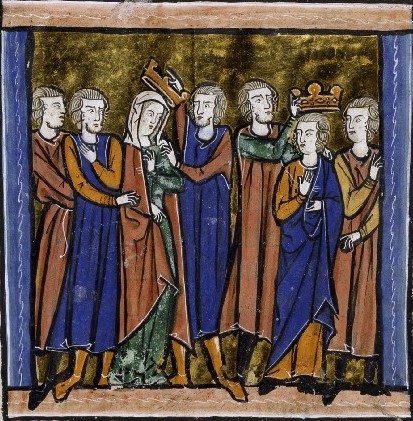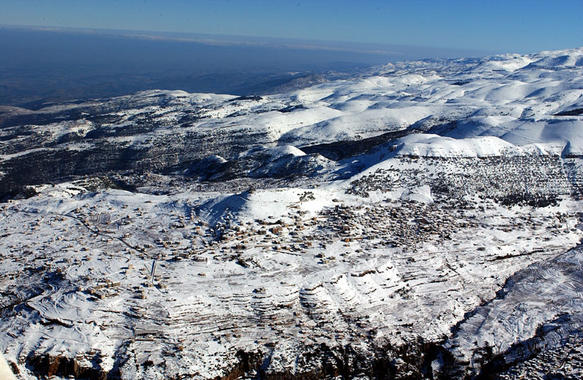|
Lord Of Beirut
The Lordship of Beirut was a feudal seigneury in the Kingdom of Jerusalem centered on the city of Beirut (in modern-day Lebanon). The lord of Beirut was one of the most powerful vassals of the king of Jerusalem. In the 12th century the lordship was ruled by the Brisebarre family. At some point between 1165 and 1174, Beirut was taken back into the royal domain. Count Raymond III of Tripoli held it in 1185-86, and in 1187 it was conquered by the Ayyubids. It was recovered in 1197, and in the 13th century the lordship was held by the Ibelin family. History First kingdom The city of Beirut was captured by the Franks and annexed to the Kingdom of Jerusalem in 1110. King Baldwin I granted it to his distant relative Fulk of Guînes. By 1125, Fulk had died, and Beirut had been given to Walter I Brisebarre. The origin of the Brisebarre family is unknown: their name does not refer to any place and no relationship with the counts of Guînes is known. Beirut owed 21 knights to the crown, ... [...More Info...] [...Related Items...] OR: [Wikipedia] [Google] [Baidu] [Amazon] |
Feudal
Feudalism, also known as the feudal system, was a combination of legal, economic, military, cultural, and political customs that flourished in Middle Ages, medieval Europe from the 9th to 15th centuries. Broadly defined, it was a way of structuring society around relationships derived from the holding of land in exchange for service or labour. The classic definition, by François Louis Ganshof (1944),François Louis Ganshof (1944). ''Qu'est-ce que la féodalité''. Translated into English by Philip Grierson as ''Feudalism'', with a foreword by F. M. Stenton, 1st ed.: New York and London, 1952; 2nd ed: 1961; 3rd ed.: 1976. describes a set of reciprocal legal and Medieval warfare, military obligations of the warrior nobility and revolved around the key concepts of lords, vassals, and fiefs. A broader definition, as described by Marc Bloch (1939), includes not only the obligations of the warrior nobility but the obligations of all three estates of the realm: the nobility, the cl ... [...More Info...] [...Related Items...] OR: [Wikipedia] [Google] [Baidu] [Amazon] |
Vassals Of The Kingdom Of Jerusalem
The Kingdom of Jerusalem, one of the Crusader states that was created in 1099, was divided into a number of smaller Manorialism, seigneuries. According to the 13th-century jurist John of Ibelin (jurist), John of Ibelin, the four highest crown vassals (referred to as barons) in the kingdom proper were the count of Jaffa and Ascalon, the prince of Galilee, the lord of Sidon, and the lord of Oultrejordain. There were also a number of independent seigneuries, and some land held under direct royal control, such as Jerusalem itself, Acre, Israel, Acre and Tyre (Lebanon), Tyre. Northern states Aside from the Kingdom of Jerusalem, there were also three other major Crusader states in the Near East: * County of Edessa * County of Tripoli * Principality of Antioch These states nominally bore some dependency on the kingdom of Jerusalem. The king of Jerusalem was bound to reconcile them in case of disputes, or between a vassal prince and the Latin patriarch of Antioch, and could claim the ... [...More Info...] [...Related Items...] OR: [Wikipedia] [Google] [Baidu] [Amazon] |
Sibylla, Queen Of Jerusalem
Sibylla (; – 25 July 1190) was the queen of Jerusalem from 1186 to 1190. She reigned alongside her husband Guy of Lusignan, to whom she was unwaveringly attached despite his unpopularity among the barons of the Kingdom of Jerusalem. Sibylla was the eldest daughter of King Amalric and the only daughter of his first wife, Agnes of Courtenay. Her father died in 1174, making her heir presumptive to her younger brother, King Baldwin IV; when it became clear that the 13-year-old king had contracted leprosy, the matter of Sibylla's marriage became urgent. The regent, Count Raymond III of Tripoli, arranged for her to marry William Longsword of Montferrat in late 1176, but within a year, William died, leaving her pregnant and in possession of the County of Jaffa and Ascalon. Shortly after giving birth to a son, Baldwin, Sibylla came to be associated with her brother in public acts, thereby being designated as next in line to the throne. Sibylla's second marriage to Guy of Lusigna ... [...More Info...] [...Related Items...] OR: [Wikipedia] [Google] [Baidu] [Amazon] |
Joscelin III
Joscelin III (c. 1139 – after 1190) was the titular count of Edessa, who during his lifetime managed to amass enough land to establish a lordship in the Kingdom of Jerusalem. Early life Joscelin III was the son of Joscelin II and Beatrice of Saone. He inherited the claim to the County of Edessa from his father, Joscelin II. The county had been captured in 1144 and its remnants (including the Lordship of Turbessel) conquered or sold years earlier. Joscelin lived in the Kingdom of Jerusalem and managed to gather enough land around Acre to set up his own lordship. Royal Guardian His sister, Agnes, had been the first wife of King Amalric before he succeeded to the throne, and was the mother of Baldwin IV and Sibylla. In 1164 Joscelin was taken captive by Nur ad-Din Zengi at the Battle of Harim. He remained a prisoner until 1176 when Agnes paid his ransom of 50,000 dinars, probably with support from the royal treasury. His nephew Baldwin then made him seneschal of Jerusa ... [...More Info...] [...Related Items...] OR: [Wikipedia] [Google] [Baidu] [Amazon] |
King Baldwin V
Baldwin V (1177 or 11781186) was the king of Jerusalem who reigned together with his uncle Baldwin IV from 1183 to 1185 and, after his uncle's death, as the sole king from 1185 to his own death in 1186. Baldwin IV's leprosy meant that he could not have children, and so he spent his reign grooming various relatives to succeed him. Finally his nephew was chosen, and Baldwin IV had him crowned as co-king in order to sideline the child's unpopular stepfather, Guy of Lusignan. When Baldwin IV died, Count Raymond III of Tripoli assumed government on behalf of the child king. Baldwin V died of unknown causes and was succeeded by his mother, Sibylla, who then made Guy king. Background Baldwin of Montferrat was born in December 1177 or January 1178 to Sibylla, sister of King Baldwin IV of Jerusalem, after whom he was named. His father, William of Montferrat, had died in June 1177. Though only 16, the king was not expected to live long, nor could he marry and have children, because he ... [...More Info...] [...Related Items...] OR: [Wikipedia] [Google] [Baidu] [Amazon] |
Regent
In a monarchy, a regent () is a person appointed to govern a state because the actual monarch is a minor, absent, incapacitated or unable to discharge their powers and duties, or the throne is vacant and a new monarch has not yet been determined. The rule of a regent or regents is called a regency. A regent or regency council may be formed ''ad hoc'' or in accordance with a constitutional rule. ''Regent'' is sometimes a formal title granted to a monarch's most trusted advisor or personal assistant. If the regent is holding the position due to their being in the line of succession, the compound term '' prince regent'' is often used; if the regent of a minor is their mother, and she is wife or widow of the king, she would be referred to as ''queen regent''. If the formally appointed regent is unavailable or cannot serve on a temporary basis, a may be appointed to fill the gap. In a monarchy, a regent usually governs due to one of these reasons, but may also be elected to ... [...More Info...] [...Related Items...] OR: [Wikipedia] [Google] [Baidu] [Amazon] |
King Amalric
Amalric (; 113611 July 1174), formerly known in historiography as , was the king of Jerusalem from 1163 until his death. He was, in the opinion of his Muslim adversaries, the bravest and cleverest of the crusader kings. Amalric was the younger son of King Fulk and Queen Melisende and brother of King Baldwin III. Baldwin was crowned with Melisende after Fulk's death in 1143. Melisende made Amalric the count of Jaffa, and he took her side in her conflict with Baldwin until Baldwin deposed her in 1152. From 1154 Amalric was fully reconciled with his brother and made count of both Jaffa and Ascalon. In 1157 he married Agnes of Courtenay despite the misgivings of the Church and had two children with her, Sibylla and Baldwin. When his brother died in 1163, Amalric was obliged to leave Agnes in order to be recognized as king. He was crowned on 18 February. Amalric's reign was marked by a ceaseless struggle with the Muslim atabeg of Damascus and Aleppo, Nur al-Din Zengi, and persiste ... [...More Info...] [...Related Items...] OR: [Wikipedia] [Google] [Baidu] [Amazon] |
Walter III Brisebarre
Walter III Brisebarre was a 12th-century Frankish nobleman who ruled successively as the lord of Beirut, lord of Transjordan, and lord of Blanchegarde in the Kingdom of Jerusalem. Walter inherited Beirut from his father, Guy Brisebarre, in 1157 and Transjordan from his father-in-law, Philip of Milly, in 1166. King Amalric forced Walter to cede Beirut to the crown to prevent a merger of two great fiefs. After the deaths of his wife Helena and their daughter, Beatrice, between 1167 and 1174, Transjordan passed to Helena's sister, Stephanie, and Stephanie's husband Miles of Plancy. Miles ruled the kingdom in 1174 in the name of the minor King Baldwin IV. He was murdered in October 1174 by assassins whom a later source names as the "lords of Beirut". Walter ended his career as the lord of Blanchegarde, a minor fief, but retained some influence at court until he died, probably in the early 1180s. Lordship of Beirut Walter was the eldest son of Guy Brisebarre, lord of Beirut. A 1164 ... [...More Info...] [...Related Items...] OR: [Wikipedia] [Google] [Baidu] [Amazon] |
Port Of Beirut
The Port of Beirut () is the main port in Lebanon on the eastern part of the Saint George Bay on Beirut's northern Mediterranean coast, west of the Beirut River. It is one of the largest and busiest ports on the Eastern Mediterranean. On 4 August 2020, a large explosion, caused by improperly stored ammonium nitrate, occurred at the port, killing at least 218 people, injuring more than 7,000 and rendering 300,000 others homeless.Cabinet declares state of emergency, port officials placed under house arrest ''Daily Star'' (5 August 2020). Large sections of the port and its infrastructure were destroyed, including most of Beirut's grain reserves, and billions of dollars in ... [...More Info...] [...Related Items...] OR: [Wikipedia] [Google] [Baidu] [Amazon] |
Lebanon Mountains
Mount Lebanon (, ; , ; ) is a mountain range in Lebanon. It is about long and averages above in elevation, with its peak at . The range provides a typical alpine climate year-round. Mount Lebanon is well-known for its snow-covered mountains, home to surviving Lebanese cedar forests and diverse high-altitude flora and fauna. The name Lebanon itself originates from the white, snow-covered tops of this mountain range. Geography The Mount Lebanon range extends along the entire country for about , parallel to the Mediterranean coast. The highest peak is Qurnat as Sawda', at . The range receives a substantial amount of precipitation, including snow, which averages around in depth.Jin and Krothe. ''Hydrogeology: Proceedings of the 30th International Geological Congress'', p. 170 Lebanon has historically been defined by the mountains, which provided protection for the local population. In Lebanon, changes in scenery are related less to geographical distances than to altitudes. The ... [...More Info...] [...Related Items...] OR: [Wikipedia] [Google] [Baidu] [Amazon] |
Damour River
Damour river or (, Nahr Al Damour) is a coastal river in the Mount Lebanon Governorate in Lebanon. The river's headwaters originate on and around the slopes of the 1,943-meter peak Jabal el-Barouk, site of a nature preserve where some of Lebanon's largest and oldest Cedars of Lebanon are found, and flows west through the Jisr Al-Kadi valley, where it receives water from the creeks of the Chouf mountains. The river flows towards the Mediterranean Sea, south of Damour, which bears the river's name. Mythology During the Phoenician time, Canaanite people being affected by drought seasons, called the river "Damoros" ancient Tamyrus,''Travels in Palestine and Syria'', Volume 1, page 286 By George Robinson in the attribution of 'Damoros' god of immortality, related to ' Achtarout', god of love and beauty. The city foundation The city was founded on the river's edge by poor people who wanted to charge the right of way to the emirs Emir (; ' (), also transliterated as amir, ... [...More Info...] [...Related Items...] OR: [Wikipedia] [Google] [Baidu] [Amazon] |
County Of Tripoli
The County of Tripoli (1102–1289) was one of the Crusader states. It was founded in the Levant in the modern-day region of Tripoli, Lebanon, Tripoli, northern Lebanon and parts of western Syria. When the Crusades, Frankish Crusaders, mostly Occitania, southern French forces – captured the region in 1109, Bertrand of Toulouse became the first count of Tripoli as a vassal of King Baldwin I of Jerusalem. From that time on, the rule of the county was decided not strictly by inheritance but by factors such as military force (external and civil war), favour and negotiation. In 1289, the County of Tripoli fell to the Muslim Mamluk, Mamluks of Cairo under Sultan Qalawun, and the county was absorbed into Mamluk Sultanate (Cairo), Mamluk Sultanate. Capture by Christian forces Raymond IV of Toulouse was one of the wealthiest and most powerful of the List of principal Crusaders, crusaders.Tyerman C"God's war – a new history of the crusades"Harvard University Press. 2009. Even so, a ... [...More Info...] [...Related Items...] OR: [Wikipedia] [Google] [Baidu] [Amazon] |







